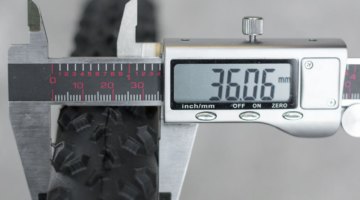
It didn't come out often during the season, but Tim Johnson was all disc and all speed on his new prototype bike. ©Pat Malach
by Molly Hurford
We didn’t see disc brakes too frequently this season, but every so often, you’d spot a set on elite wheels, including those of Tim Johnson with his Cannondale SuperX. And with companies like Felt coming out with new, relatively inexpensive disc-equipped cyclocross bikes for the upcoming season, we wanted to check in with our mechanics and find out what the scuttlebutt surrounding the new braking style is. For a video tour of the new Felt bike, check out our look at the Felt 65X Disc-Equipped bike.
Check back soon as we get more responses from other mechanics!
Brett Rothmeyer, Pro Bikes:
As a ’cross racer myself, the first thing I think about when the idea of switching to disc brakes comes up is money, and how much of it I have invested in wheels and tires for my current bikes. Chances is are if you are a “serious” ’cross racer, you probably have at least a couple pairs of wheels and tires for different courses conditions, all of which will be obsolete once switching to disc brakes. As far as the bikes go, most of the disc frames I have seen are going to have traditional rear spacing at 130mm, so the option of running your sweet Stan’s disc wheels from your mountain bike won’t be an option in most cases.
I do think, however, if you are looking for your first ’cross bike or have a large bank account, disc brakes are a great option. I’m really looking forward to see what all the components companies are going to come out with in the next few years. With pros like Tim Johnson already running disc brakes and companies like SRAM developing hydraulic brakes integrated into their already popular Red shifters, it seems disc-brake-equipped ’cross rigs will become a regular sight at the local races.
Chris Mayhew, JBV Coaching:
Well, I don’t work in a shop so I’m not installing any. I am certainly fielding a lot of questions from people though. Really, I’m fielding about just as many questions about short arm V-brakes as I am about disc brakes. And I always point people to the Cyclocross Magazine tech section for articles, since you did a ton of good research on the issue!
Honestly, I’d say hold off on switching. The first year runs of stuff almost never go well with this sort of thing. I feel like especially since foreign manufacturing has taken over carbon, it’s gotten even worse. I’ve seen so many cracked carbon bikes than in the last five years. Also, there are some difficulties involved in designing the fork and I am not at all convinced the industry will get that right the first time. Look at MTB disc brake fork tabs, for instance.
I think time will tell. All of us have a position on the issue but very few of us have ever really ridden or raced on them. It’ll take some time racing them to form a consensus on the issue, and one that will vary from region to region. In MABRA, they’ll be almost useless. Portland or New England, who knows? The issues I’m not seeing talked about are brake drag and wheel changes and that’s something we’ll have to experience as well.
That said, they have a lot of potential. They could be game-changing in a way I am not stoked about. On the other hand, execution matters a lot. For years, the industry has just slapped together ’cross bikes without thinking about them as their own category. So trying to cobble this together as a skinny tire MTB is not going to work. Could be Mavic ZAP, could be Shimano DI2.
My advice to a client would be sit back and let it happen. You’re not going to be at any huge disadvantage and there are pretty limited circumstances in which they will be an advantage. See what happens, make a decision next year.
Jason Gardner, Jinji Cycles:
I haven’t installed any discs on newer models yet. Redline has had a disc-ready frame for a while, and I’ve got a few people with those. I have yet to see more than a couple of the gap-filling styles like TRP’s and Hope’s mechanical-to-hydraulic adapters. Most people I encounter still view those a bit dubiously. With all that said, this is the question I’ve been getting the most from cyclocross-addicts lately. The lack of ready frames, especially at the higher end, is the number one reason my riders give for not jumping on yet.
Judging from the most recent Interbike and NAHBS pictures, that is definitely changing. I know I’ll see more this year. My first advice for someone considering the jump is spend the money to get the higher-end brakes. They’re not that much more and the adjustability and reliability are notably superior. Second, if you are accustomed to using two sets of wheels, I suggest making every effort to ensure that those two wheelsets use the same hub. In my opinion, this is going to be one of the most difficult issues with using disc brakes on race equipment. The hubs aren’t all the same dimensions. If the hubs do not set the rotor in the exact same place, it will result in brake rubbing, sometime minor, sometimes major. If your two wheelsets have the same hubs, you will have much easier wheel changes. Unfortunately, you won’t be able to take just any wheel. It’s a big consideration, but it also has potentially big consequences. It’ll be even more important in road racing, where there is much more neutral wheel support.
Are they the next big thing? If the marketing departments say so.
Stay tuned for more opinions.




























